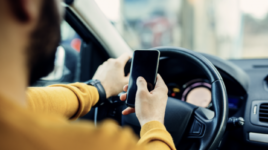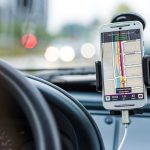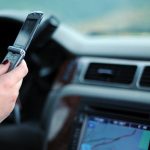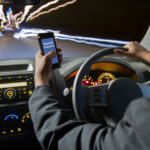How To Get Off A Mobile Phone Offence in New South Wales

Traffic offences raise a lot of revenue for the NSW government, and it can sometimes feel helpless when you receive a fine for an alleged breach of the road rules that you didn’t commit.
One of the most common infringements issued in NSW is in regard tot he use of a mobile phone whilst driving.
The following outlines this offence and outlines a number key strategies to defend against paying a fine for a mobile phone related offence.
The NSW offence of driving whilst using a mobile phone
Different offences apply depending on whether a driver is fully licensed or a ‘restricted driver’ (that is, on a probationary license).
For fully licensed drivers, regulation 300 of the Road Rules 2014 states that:
The driver of a vehicle must not use a mobile phone while the vehicle is moving, or is stationary but not parked
For restricted drivers, regulation 300-1 of the Road Rules 2014 states that:
The driver of a motor vehicle (except an emergency vehicle or police vehicle) who is the holder of a learner licence or a provisional P1 or P2 licence must not use a mobile phone, whether or not held by the driver, while the motor vehicle is moving or is stationary but not parked.
‘Use’ of a mobile phone is defined as:
(a) holding the body of the phone in her or his hand (whether or not engaged in a phone call), except while in the process of giving the body of the phone to a passenger in the vehicle,
(b) entering or placing, other than by the use of voice, anything into the phone, or sending or looking at anything that is in the phone,
(c) turning the phone on or off,
(d) operating any other function of the phone.
At the time of writing, a penalty notice of $387 applies to using a mobile phone while driving which increases to $514 if this occurs in a school zone. Each offence carries 5 demerit points. However, this is subject to change and can be checked on the NSW Government website.
If an election is made to take the case to court, the maximum fine increases to 20 penalty units for either offence, which is currently equivalent to $2,200.
So, it is important to seek the advice of experienced traffic lawyers before choosing to take the matter to court.
Getting a mobile phone offence thrown out in New South Wales
It is important to be aware that in order to establish a mobile phone offence, the prosecution must prove beyond a reasonable doubt that you were actually using a phone in unlawful circumstances.
A photo taken by a mobile phone camera can amount to evidence you were committing the offence.
That being the case, you will often need to present evidence – whether in the form of your own testimony and/or that of a passenger/s – which disproves a requirement for the offence.
This could include that:
- You were not using your mobile phone at any point whilst in control of a vehicle (including where you were simply passing it to a passenger); or
- You have been misidentified as the driver of the vehicle; or
- A statutory exception applies; or
- A general legal defence applies.
You can raise these concerns when requesting a review of a fine or when challenging the fine in court.
Statutory exceptions to an offence of driving while using a mobile phone
A number of formal statutory exceptions exist under the Road Rules 2014, which may also be raised.
For fully licensed drivers, the offence will not apply if:
(a) the phone is being used to make or receive an audio phone call or to perform an audio playing function and the body of the phone:
- is secured in a mounting affixed to the vehicle while being so used, or
- is not secured in a mounting affixed to the vehicle and is not being held by the driver, and the use of the phone does not require the driver, at any time while using it, to press any thing on the body of the phone or to otherwise manipulate any part of the body of the phone, or
(b) the phone is functioning as a visual display unit that is being used as a driver’s aid and the phone is secured in a mounting affixed to the vehicle, or
(c) the vehicle is an emergency vehicle or a police vehicle, or
(d) the driver is otherwise exempt from the rule under another law.
A visual display unit used as a driver’s aid includes:
- Closed-circuit television security cameras,
- Dispatch systems,
- Navigational or intelligent highway and vehicle system equipment,
- Rear view screens,
- Ticket-issuing machines, and
- Vehicle monitoring devices.
A further exception to the rule against using a mobile phone while driving or riding is where the vehicle is stationary in a road-related area (not on a road), and:
- is functioning as a payment device to enable the driver to pay for goods or services that are required to be paid for in the road related area, or
- is being used to display an electronic coupon, voucher, card or similar article that requires the body of the phone to be held in close proximity to another device located in the road related area in order for the article to be used or redeemed, or
- is being used as an electronic device that enables the driver to enter another road related area or land adjacent to the road related area.
A ‘road related area’ is defines as:
- an area that divides a road
- a footpath or nature strip adjacent to a road
- an area that is open to the public and is designated for use by cyclists or animals
- an area that is not a road and that is open to or used by the public for driving, riding or parking vehicles
- a shoulder of a road, or
- any other area that is open to or used by the public and that has been declared under to be an area to which specified provisions of the Road Transport Act or the statutory rules apply.
This includes drive through establishments.
For restricted drivers, the statutory exceptions are much more limited, but include if they are stationary in a road-related area (not on a road), and the phone:
- is functioning as a payment device to enable the driver to pay for goods or services that are required to be paid for in the road related area, or
- is being used to display an electronic coupon, voucher, card or similar article that requires the body of the phone to be held in close proximity to another device located in the road related area in order for the article to be used or redeemed, or
- is being used as an electronic device that enables the driver to enter another road related area or land adjacent to the road related area.
Formal defences to an offence of driving while using a mobile phone
Along with the statutory exceptions outlined above, a person may be able to challenge the offence in the basis of a formal defence under law.
This can include self-defence, duress or necessity.
Arrangements for financial hardship
If you do not wish to challenge the fine you’ve received but will struggle to pay the fine amount in time due to financial hardship, you can make a formal require to pay off the fine in instalments.
You may be able to pay by instalments if you:
- Receive a government benefit;
- Can pay the full amount within three months;
- Need longer than three months to pay;
- Are already paying off other fines.
It’s important to request to pay in instalments as soon as possible to avoid extra fees.
Going to court over a traffic offence?
If you are you going to court to contest a traffic offence, call Sydney Criminal Lawyers anytime on 9261 8881 to arrange a free first conference during which one of our experienced defence lawyers will assess the case, advise you of your options and the best way forward, and fight for the optimal outcome.






